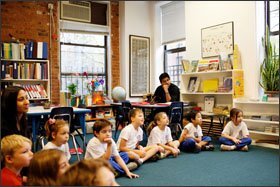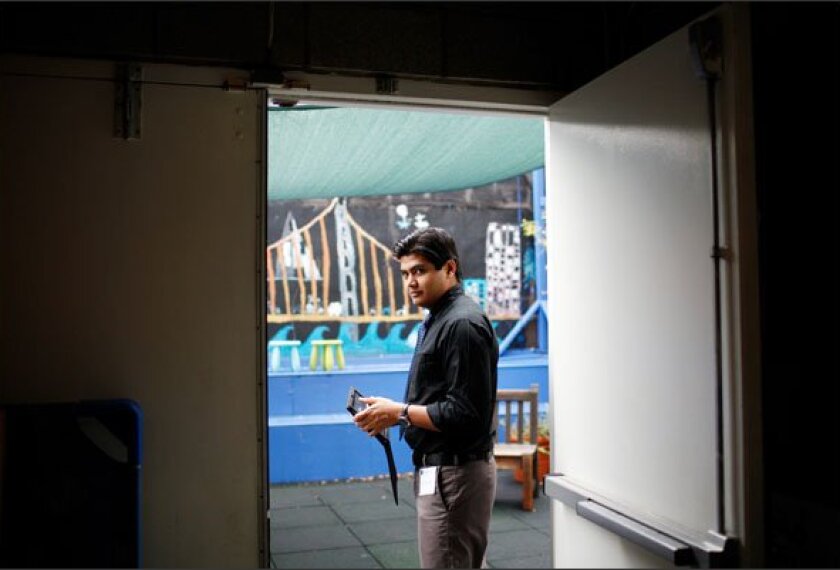While much of the current policy discussion around international education focuses on how American students stack up against their peers in Europe and Asia and which international models offer lessons for American schools, one Indian educator is visiting the United States in search of models he can import to a slum of his hometown of Mumbai.
Gaurav Singh, a Mumbai teacher who plans next summer to open a free school in a slum more populated than New York City, is among a new group of international education entrepreneurs who suggest there may be value in U.S. schools exporting their own models to developing schools, too.
Mr. Singh is one of three education entrepreneurs spending six months to a year studying American schools as part of a residency program launched this year by the Washington-based , which aims to help international educators set up networks of free public schools to share best practices. During his six-month stint in the United States, Mr. Singh has been visiting district, charter, and private schools for a few days to several weeks.
Mr. Singh said he has been getting numerous ideas from the 18 schools he’s visited so far, for everything from school finances to teacher training, pedagogy, and supplemental enrichment.
“Where do you go in India to see what’s possible for a kid who comes from a slum? Not at a comparative level of, ‘Let’s give them a few skills to work in a coffee shop,’ but on an absolute level, what’s possible?” he said. “There’s not much we can look at.”
‘Excellence Is Excellence’
The first visits to American classes full of desks and interactive white boards were a major culture shock, Mr. Singh recalled. As a member of the founding class of , a nonprofit modeled after Teach for America, he had started teaching two years ago after five weeks of training with a 2nd grade group of 50 students ranging in age from 6 to 14. Classes took place sometimes in a classroom and sometimes in buildings or sidewalks.
“When you enter a classroom that’s very different from yours in terms of space, in terms of number of kids, … you just say, ‘This is not going to work in our country,’ ” he said. “You have to calm yourself and say, ‘This is useless; excellence is excellence,’ and then figure out how we can transfer these practices. We needed to hunt for the big nuggets. Now, I’m actually going back thinking, it’s not that different.”
Mr. Singh’s “3-2-1 School” will open with 120 students in kindergarten and 1st grade, adding a grade each year. And unlike most public schools in India, which operate for four hours a day, six days a week, Mr. Singh said his school will operate on something like an American schedule of 8 a.m. to 3 p.m., five days a week. The school will start out with a student-teacher ratio of 30-to-1, in line with new national rules expected to go into effect in the next three years.
Students will enroll via a lottery, and Mr. Singh is planning for at least a two- to four-year age range in each grade, as well as considerable language diversity. The children, mostly from Mumbai’s slums, speak more than 16 languages. He said he has been choosing U.S. schools to visit based on specific practices—a character-development program in one, teacher professional development in another.
The educator said his goal is to have 100 percent of students scoring “proficient” on the , or ASSET, India’s standardized test, by the time the kindergarten cohort reaches 3rd grade.
There is no formula-based government aid for public schools in India; the government will decide whether to provide funding for the 3-2-1 School based on its academic achievement, said Mr. Singh, who has set a goal of having a network of 100 K-12 schools in 15 years.

He has some reason for confidence: During the teaching fellowship with Teach for India, Mr. Singh’s students progressed 2.6 grade levels on average in a school year. “Once we started overlooking the resource constraints that we had, we started finding that learning was happening, and happening on grade level,” he said. “When we started seeing that the kids could learn whether they had a blackboard or not, whether they had a classroom or not, it started teaching us a lot of things about learning and about joy.”
As Mr. Singh toured a Montessori school in New York City last week, a delegation of U.S. Department of Commerce officials and higher education officials were in Mumbai, New Delhi, and Chennai, looking at Indian schools and recruiting students to study at American schools. That mission focused on colleges and universities, according to Kristian Richardson, a senior international trade specialist for the agency, but he said the department would as readily export K-12 school models if American educators were willing to pitch them overseas. For the past eight years, Indian students have been the largest group of international students studying in the United States, and the department believes “this population will continue to grow as demand for education in India outweighs the supply of available institutions.”
Exporting Schooling
The Commerce Department “actively promotes U.S. education as an export” through education missions like this one, and it considers education to be one of the country’s top 10 service exports. International students accounted for more than $18.8 billion in tuition and living expenses while studying in the United States during the 2009-10 school year.
Yet there are relatively few opportunities for education leaders like Mr. Singh to get a firsthand look at U.S.-style learning, according to Robert Spielvogel, the chief technology officer and vice president for research, evaluation, and policy for the Newton, Mass.-based Education Development Center, a research-and-consulting organization that helps establish basic education in developing countries. And, while numerous American colleges have created satellite campuses in other countries, the idea hasn’t caught on yet in the K-12 sector beyond the international schools that generally serve children of American diplomats. In Mumbai, Mr. Singh said the American international school costs $15,000 per year—far more than the $1,000 U.S. dollars the average Indian earns in a year.
“There’s been surprisingly little of that in the [United States],” Mr. Spielvogel said. “The charter networks in the U.S. ... have focused more on states, not spreading themselves internationally.”
Norma A. Evans, an EDC senior research and development associate who builds literacy programs in Africa, said much of the research that undergirds her development work comes from the United States, but “we haven’t tried to transfer a packaged or predefined school model for a number of reasons, the most obvious being the need to recognize and respect the curriculum and instructional setup mandated by the host countries.”
“We try [to] weave our instructional practices and models into existing frameworks. That said, we do hope that over time and as ministries see the impact of the new practices on student learning, they will begin identifying how to mainstream the practices and models,” Ms. Evans said.
Edvillage was founded this year by two former leaders from the Knowledge Is Power Program Foundation: former KIPP business director Mark Medema, the current Edvillage president; and former KIPP outreach and institutional advancement director Allison Rouse, the group’s chief executive officer.
“We’d both opened a number of charter schools in the states in the last decade and then spent some time overseas,” Mr. Medema said. “We noticed the huge demand for education reform initiatives in other countries. The stories weren’t much different from the problems we were facing here in the United States, so we came back to the U.S. and thought hey, maybe there’s an opportunity to share the lessons—the good, the bad, and the ugly—that we’ve learned here in the U.S. about education reform with other countries.”
The nonprofit got a two-year, $700,000 start-up grant from the Michael & Susan Dell Foundation. Mr. Singh and two South African educators were recruited to be the first program residents, and the group is now recruiting 16 educators from India, South Africa, and Latin America for next year.
The EDC’s Mr. Spielvogel predicts the Internet will accelerate international interest in American educational practices.
“Even in the poorest countries, there is a desire to be up to date and incorporate 21st-century learning,” he said. He also expects that accreditation programs like the International Baccalaureate and open-source education services will continue to grow. “As people get familiar with educational materials they might start to get interested in more of the pedagogy.”






